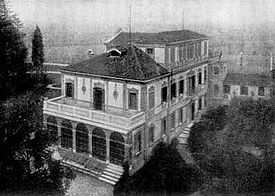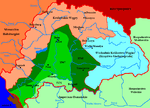Armistice of Villa Giusti
The Armistice of Villa Giusti ended warfare between Italy and Austria-Hungary on the Italian Front during World War I. The armistice was signed on 3 November 1918 in the Villa Giusti and was to take effect 24 hours later.
Background
By the end of October 1918, while its definitive defeat was being perpetrated at the Battle of Vittorio Veneto, the Austro-Hungarian Army found itself in such a state that its commanders were forced to seek a ceasefire at any cost.
During the Battle of Vittorio Veneto, the troops of Austria-Hungary were defeated, ceasing to exist as a combat force and starting a chaotic withdrawal. From 28 October onwards, Austria-Hungary sought to negotiate a truce but hesitated to sign the text of armistice. The Italians, in the meantime, advanced reaching Trento, Udine, and landing in Trieste. After the threat to break off the negotiations, on 3 November the Austro-Hungarians accepted the peace terms. The cease-fire would be started at 3.00 pm on 4 November, but due to a unilateral order of the Austro-Hungarian high command, the empire's forces stopped fighting on 3 November. After the war, the Kingdom of Italy annexed the Southern Tyrol (modern Trentino-Alto Adige/Südtirol), according to London Pact terms as well as Trieste and the Austrian Littoral.


Signatories
Italy:
- Tenente Generale Pietro Badoglio
- Maggior Generale Scipione Scipioni
- Colonnello Tullio Marchetti
- Colonnello Pietro Gazzera
- Colonnello Pietro Maravigna
- Colonnello Alberto Pariani
- Capitano di Vascello Francesco Accinni
Austria-Hungary:
- General Viktor Weber Edler von Webenau
- Oberst Karl Schneller
- Fregattenkapitaen Johannes Prinz von und zu Liechtenstein
- Oberstleutnant J.V. Nyékhegyi
- Korvettenkapitaen Georg Ritter von Zwierkowski
- Oberstleutnant i.G. Victor Freiherr von Seiller
- Hauptmann i.G. Camillo Ruggera
See also
Bollettino della Vittoria address of General Diaz to his troops and the nation after the Armistice of Villa Giusti
External links
| ||||||||||||||||||||||||||||||||||||||||||
